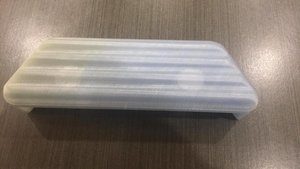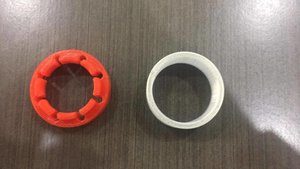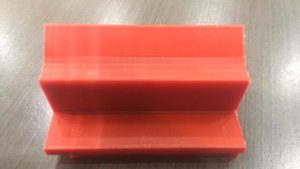 A few weeks ago, we learned about an Australian company called AONIQ and its industrial 888 3D printer, which is set to go on sale at the beginning of August. One notable feature of the 888 is that it 3D prints with polyvinyl chloride, or PVC, which is one of the most commonly used polymers in the world; however, it’s a brand new material to 3D printing, introduced for the first time only last year. The emergence of PVC into the 3D printing materials market is an exciting development, as it’s a highly versatile and durable material with applications spanning industries such as automotive, constructive, health care and much more. It’s also a more sustainable material than many plastics, as it’s energy-efficient and can even be made without the use of oil.
A few weeks ago, we learned about an Australian company called AONIQ and its industrial 888 3D printer, which is set to go on sale at the beginning of August. One notable feature of the 888 is that it 3D prints with polyvinyl chloride, or PVC, which is one of the most commonly used polymers in the world; however, it’s a brand new material to 3D printing, introduced for the first time only last year. The emergence of PVC into the 3D printing materials market is an exciting development, as it’s a highly versatile and durable material with applications spanning industries such as automotive, constructive, health care and much more. It’s also a more sustainable material than many plastics, as it’s energy-efficient and can even be made without the use of oil.
While PVC 3D printing is still a rarity, AONIQ believes that it will catch on quickly, even replacing ABS eventually as the go-to polymer material for additive manufacturing. We’ve been very curious about this material ourselves, so we had A Few Questions For AONIQ Founder and CEO Michael Slavica, who told us more about what we can expect from PVC.
What can you tell us about the safety of 3D printing with your PVC?
“The 888 3d printer has been designed to print PVC and its perfectly safe to do so. We are printing it out at a maximum of 200 degrees and at that temperature we have seen almost no thermal decay but we decide to do testing at an elevated temperature in case customers didn’t adhere to recommendations.
To that end we have untaken NATA accredited laboratory (National Australian Testing Association) ISO and AUS/NZ testing for Gaseous Hydrochloric (HCL) emissions due to thermal decay of PVC at elevated temperatures, the exposure temperature was inflated to 210°C / 410°F rather than the required test temperature 180°C / 356°F to reflect the actual print head temperatures and the result we needed was to be in line with real world usage and application
The testing proved that AONIQ PVC filament material does not start to emit corrosive HCL gas unless AONIQ PVC resin was subject to 210°C for over 11 minutes, the conclusion is, the likely corrosive effect on metallic surfaces would be virtually unmeasurable during normal printing activities as the thermal exposure time of 1.75Ø PVC filament in the 888 is well below the Time vs Thermal Exposure threshold.
The only time this would be a concern is if the best practice usage guidelines were not followed and the PVC filament were to be allowed to sit idle in an elevated temperature print head for longer than 11 minutes.
As another safety measure our enclosure has a charcoal Hepa filter that would remove any emissions should a customer not follow usage guidelines. Thus making printing with PVC completely safe.”
How does your PVC compare to that in development from Chemson Pacific?
“I have personally seen Chemson PVC 3d printed in real life and it looks amazing to be honest so I would from eye sight only say they appear to be the same quality.”
Why do you think it’s Australian companies leading the way in 3D printing with PVC?
“Its hard to say but I think it could probably be similar to the story of the 4 minute mile. In 1954 Roger Bannister did the impossible he ran the mile in under 4 minutes which at the time was considered impossible by all the experts in fact, people believed that you would die if it was achieved. Once Roger broke it though 24 people followed with in a year and I would equate that with us once we knew it could be done we went about making our own.”
What can you tell us about the team behind the development of your PVC?
“We are a very close knit team with vastly different skill sets that have balanced our knowledge base against one another we have plastics experts, manufacturing experts, programing and software experts and 3d printing experts which balances us perfectly.”
How does the 10-roll minimum order deter those who might not be serious about working with this material?
“We really want to avoid the inexpensive hobbyist end of the market unless they are proficient with their machines. By requiring a minimum order we hope to discourage people who aren’t serious. If we got a lot of people trying PVC who don’t have the knowledge and skills to diagnose when their machine or files are causing problems then they could blame the filament. This would then slow the adoption of PVC as the 3d printing filament of choice by industry.”
Do you offer samples so a potential serious user might test the material before investing upwards of $1,000?
“Not at this stage. We are really looking for users that share our passion for moving 3d printing into the next stage. PVC 3d printing offers a lot of opportunity for the people that can find the right applications and solutions in their respective fields.”
When do you expect 3D printable PVC to make an impact on the market?
“It will depend on the ideas of our customers. I would expect that some customers will buy our printer and filament to establish a repair business. Others will use it ensure that they remain competitive in the 3d printing services space. I think you will see that quite quickly commercial 3d printing will shift to PVC and away from ABS.”
Can you tell us what’s next for AONIQ?
“We have a range of exciting developments lined up. We have delivered our affordable industrial 3d printer and PVC 3d printing filament. Shortly we look to provide what we believe is the best build surface available for FFF printers. We have incorporated this into the 888 and want to make it available other industrial printers. There are a range of innovations that we have queued up.”
AONIQ is selling its PVC starting at $1,490 for 10 rolls. The 888 3D printer is also available for pre-order, starting at $10,499. You can check out all of the company’s product options in its online store here.
Discuss in the AONIQ forum at 3DPB.com.
Subscribe to Our Email Newsletter
Stay up-to-date on all the latest news from the 3D printing industry and receive information and offers from third party vendors.
You May Also Like
3D Printing News Briefs, November 23, 2024: Formnext Awards, Batch Production, & More
We’re covering a variety of stories in today’s 3D Printing News Briefs, from the Formnext Awards to metal additive manufacturing for batch production and more. Read on for all the...
Formnext Day Three: Rock & Zoll
The biggest news on day three was, of course, the reactions to the band at the exhibitor’s party. The soirée was well attended, with the crowd rocking on until early...
Formnext 2024 Roundup: Pellet 3D Printing, Advanced Software, & More
Europe’s leading additive manufacturing trade show, Formenxt 2024, comes to a close today. There have been many product, material, software, and other business announcements during the event, and we’ll summarize...
Formnext 2024 Day Two: Stand Up
The complaints about the film The Longest Day being set on a beach in France pale in comparison to experiencing Formnext. By the second day, it already feels like the...









































